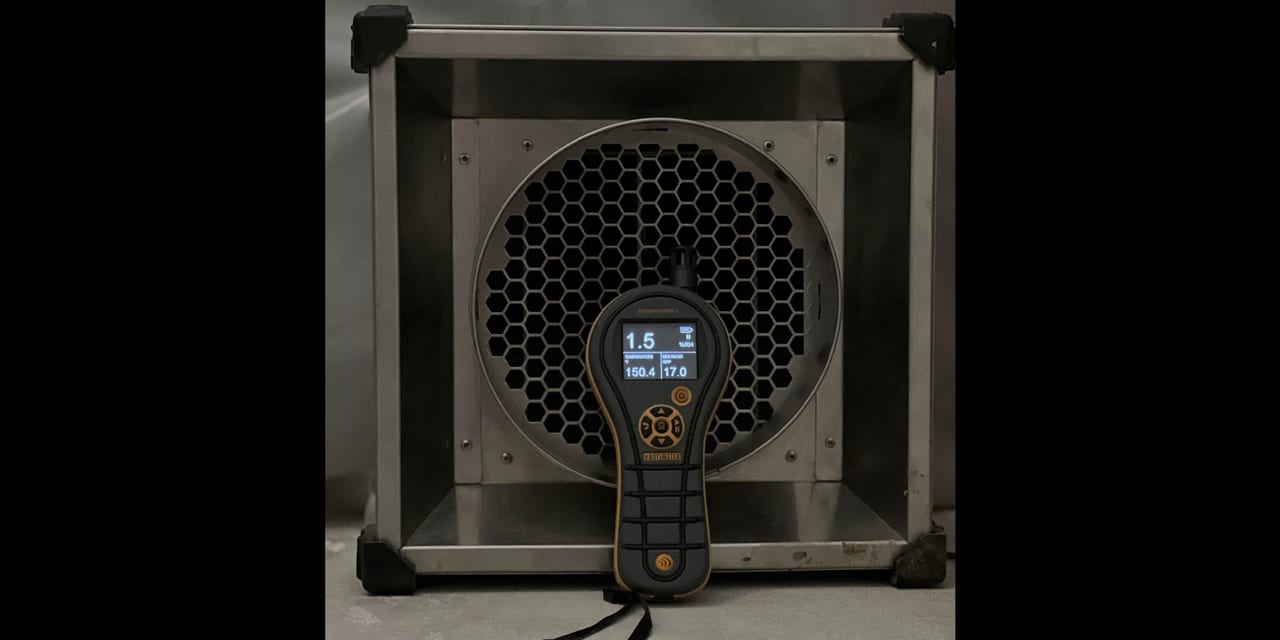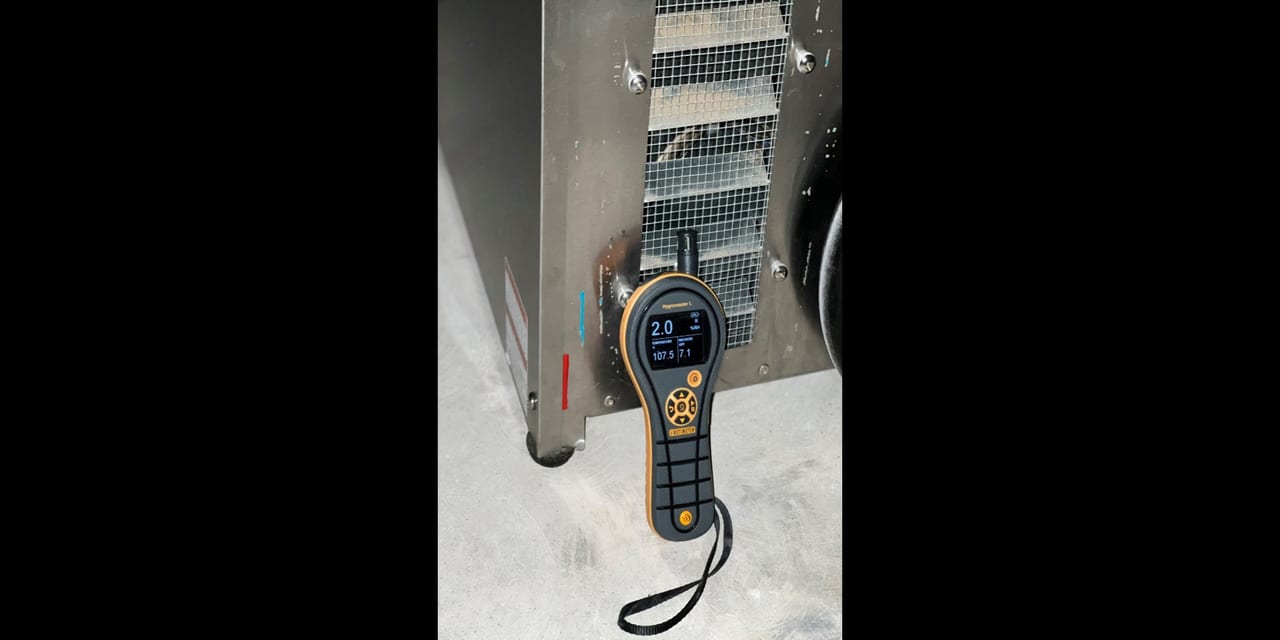




Photos credit: Kyle Herndon
The Basics of Heat
and How It Is Utilized in Drying
By Kyle Herndon
As many restorers are aware, heat is an element used to warm up cooler objects. The more important question is: What is heat and how can it be utilized in drying?
There are three ways that heat can be transferred: Conduction, infrared radiation and convection.
- Conduction is the act of vibration of molecules to create the heat source. Have you ever held an ice cube in the palm of your hand and watched it melt? This is conduction. As the warmth of the hand heats up the ice cube, the molecules from the hand quickly vibrate, warming the cold or cooler molecules of the ice cube, causing it to speed up and melt (heat) the cube.
- Infrared radiation is a form of electromagnetic radiation that causes an object to heat. This form is invisible to the naked eye, but the warmth of the heated object can be felt. Infrared radiation causes the object to build energy by variation of movements, thus creating heat to develop. An example would be the use of a microwave. While we cannot see the energy being distributed to the object within the microwave, once the food is removed, it is warm or hot to the touch. Infrared radiation causes the object to heat up by transferring the electromagnetic energy into the object's molecules. This process bends, rotates and vibrates the object's molecules, causing the object to heat up.
- Convection occurs when you take a heat source and put it in a movable medium. Convection is the only type of heat that rises since air is a medium and the thermic reaction transfers the energy via conduction. This occurs as the air absorbs the thermal energy and its molecules accelerate, taking up more space. The accelerated molecules move and bounce in the medium, causing them to move away (expansion). The air expands, allowing the air to hold more water, and as it expands, it becomes less dense, rising through the medium (air).
Heat is Energy
Thermal energy creates diffusion, resulting in the water being drawn to the heated surface. It cools, causing a reduction of its energy. The solution is to add thermal energy continuously.
It is essential to create a well-balanced equipment formula (drying plan) that allows heat to draw out the moisture, air movement to evaporate, and flushing and dehumidification to continuously dry and provide the appropriate air. Too much or lack of enough heat can significantly impact your drying success.
BTU (IICRC S500)
A British thermal unit (BTU) measures the heat content of fuels or energy sources. It is the quantity of heat required to raise the temperature of one pound of liquid water by one degree.
- 1 kilowatt-hour = 3,412 BTU
- BTU/HR = (V * I) * 3.412
- 1 Velo air mover 115v 1.9 amps
- (115 * 1.9) = 218.5 * 3.412 Totals… 745.52 BTU/HR
One BTU is approximately equal to the energy released by burning a match. Imagine the heat produced of a typical dry-out being 10 fans, a dehumidifier and an air scrubber; this common drying equipment creates its own heat/energy naturally.
Enthalpy
The enthalpy of moist air includes both the heat absorption capacity of the dry air, called sensible heat, and the capacity of the evaporated water in the air called latent heat.
Moist air is a mixture of dry air and water vapor. The total enthalpy – sensible plus latent – is used when calculating cooling and heating processes.
Thermal Expansion
Thermal expansion occurs when the mass of an object expands due to the effect of heat. Thermal expansion occurs in solids, liquids and gases. Thermal expansion has three expansion forms:
- Linear expansion
- Area expansion
- Volume expansion
An increase in temperature makes the water molecules more energetic. Thermal expansion increases materials’ porosity, increasing the rate of diffusion and evaporation.
Heat-sensitive materials should be identified and addressed when using extreme heat. Due to high heat, heat-sensitive materials such as woods, plastics, glues, adhesives and anything with a poly finish (plastic) are high-risk items.
Benefits of Heat
Heat is used in high-humidity areas such as tropical spaces to replace dehumidifiers. Heat creates a more significant grain depression and vapor pressure differential, which will not work efficiently in dehumidifiers.
Water activity is very temperature-dependent, reducing microbial and bacteria growth.
Heat can accelerate your drying of wet building materials. However, dehumidification and exhausting or building flushing are typically necessary to reduce secondary damages caused by an increase in the rate of evaporation in the air.
Heat reduces chances of secondary damages from collected moisture by dew point. Most restoration contractors do not monitor surface temperatures where moisture may condensate, causing additional damages. The materials that are impacted by the dew point are too cold, and the job site has an improper balance of airflow and dehumidification. Heat, dehumidification and airflow (evaporation from liquid to gas) should always be well balanced while drying.
Heat Drying for Concrete vs. Desiccant Dehumidification
Heat drying results are greater due to the immediate grain depression, vapor pressure differential and atmospheric changes. Category 4 materials can benefit from heat drying due to the ability to open the pores/capillaries and accelerate drying by immediate favorable vapor pressure differential. Combination of heat drying with desiccated air provides 30% greater drying time.
Increasing the atmospheric temperature by 20 degrees can reduce relative humidity by almost 50%, where the high-temperature humidity can be flushed (vented out).
Heat is capable of drying wet materials faster as opposed to cooler environments. Radiant heat energy can dry concrete at a greater rate than desiccants. Heat is the best way of drying crawlspaces. Sufficient exhausting is required to prevent moisture migration.
Infrared (IR) technology paneling directly increases the heat to the wet materials creating an immediate increase in vapor pressure differential (rate of drying). IR panels are great for heat-sensitive environments, and I typically recommend IR panel drying for spot drying tile or concrete. IR provides a 50-degree surface temperature increase with little to no atmospheric changes. Creating surface temperature differential creates wet material to increase diffusion and evaporation by increasing the vapor pressure of material (high) to seek (draw) toward atmospheric low vapor pressure. The more significant the difference in vapor pressure between the wet material and the atmosphere, the faster the evaporation rate.
Direct heat to wet building material creates a high vapor pressure. Proper dehumidification provides low vapor pressure. The greater the difference in material and the atmosphere, the faster the rate of drying (VP differential). High vapor pressures seek low vapor pressure in the process of the wet material and the atmosphere's dryer air are trying to equalize.
Disadvantages of Heat
Heat rises by transferring energy by convection. Heat should be utilized by advanced restoration technicians who understand psychometry well.
It takes energy to excite the water molecules for diffusion, and when the water molecules reach the surface for evaporation, a "cooling effect" occurs where additional energy is needed.
Heat drying without proper monitoring of atmospheric "layers" can cause moisture to migrate to unaffected areas or materials.
Heat is energy that can have a considerable evaporation rate due to air expansion. Heat thermals that create lift can push moisturized hot air into drier, cooler materials and areas. Excessive heat (energy) can force moisture into unwanted areas and materials.
Rapid cooling post-heat drying can reverse drying success.
The expanded hot air allows more moisture into the air; if not flushed or dehumidified correctly, it will equalize with building materials when the air is cooled. When heated, the air allows for more moisture to be carried due to its expansion, and when cooled, the air condenses, reducing the amount of moisture it can hold. This typically happens after removing drying equipment, and technicians believe they have reached the material's natural moisture content.
To avoid this, dehumidification and flushing should be utilized until the atmospheric conditions have reached reasonable thresholds. It is recommended that you monitor post drying for 48 to72 hours after removing equipment. You should perform atmospheric layer testing daily. Testing the atmospheric conditions every four feet in height provides vital drying information. When using heat drying as a strategy, it is recommended to monitor it two times daily.
Kyle Herndon has been in the remediation industry since the age of 14. He has over 20 years of experience and holds a voluminous range of certifications. Herndon has more than 20 certifications and holds an IICRC Triple master designation. He is the CEO of Scientific Restoration Specialists Incorporated, a licensed contractor, remediation and catastrophic response company based out of Los Angeles County, Calif. Herndon currently focuses his time as a large loss specialist and as a litigation consultant. His goal is to become an IICRC instructor where he feels he can make an industry impact.

